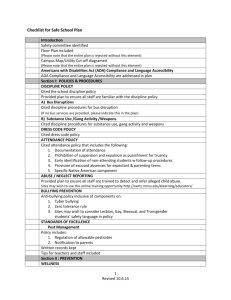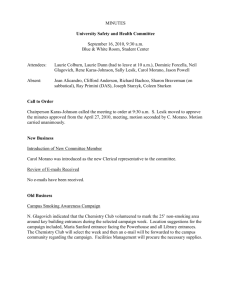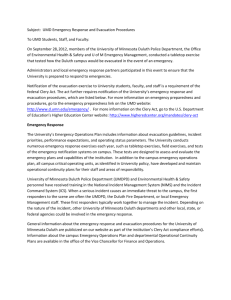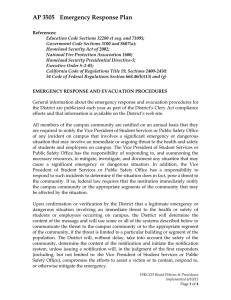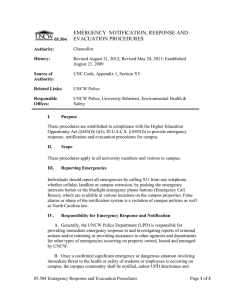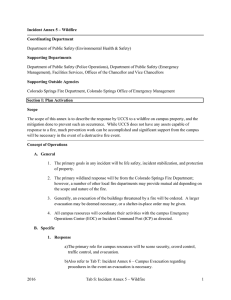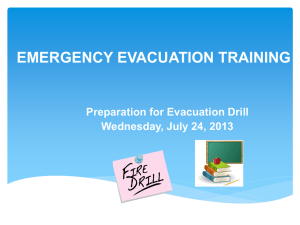emergency response and evacuation plan
advertisement
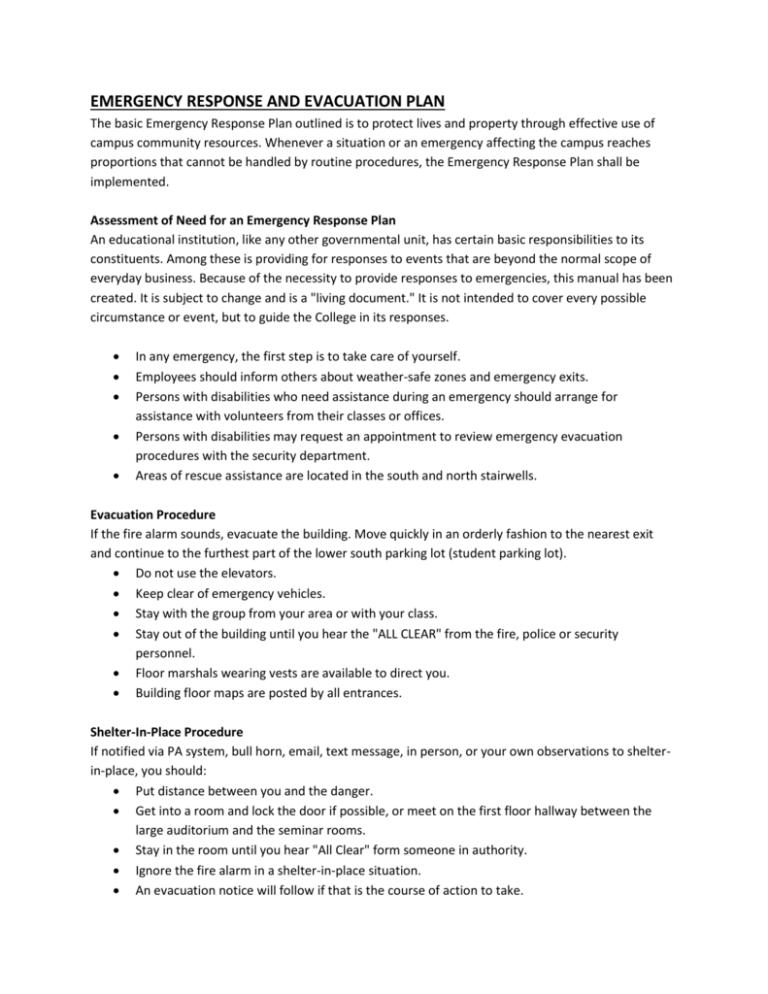
EMERGENCY RESPONSE AND EVACUATION PLAN The basic Emergency Response Plan outlined is to protect lives and property through effective use of campus community resources. Whenever a situation or an emergency affecting the campus reaches proportions that cannot be handled by routine procedures, the Emergency Response Plan shall be implemented. Assessment of Need for an Emergency Response Plan An educational institution, like any other governmental unit, has certain basic responsibilities to its constituents. Among these is providing for responses to events that are beyond the normal scope of everyday business. Because of the necessity to provide responses to emergencies, this manual has been created. It is subject to change and is a "living document." It is not intended to cover every possible circumstance or event, but to guide the College in its responses. In any emergency, the first step is to take care of yourself. Employees should inform others about weather-safe zones and emergency exits. Persons with disabilities who need assistance during an emergency should arrange for assistance with volunteers from their classes or offices. Persons with disabilities may request an appointment to review emergency evacuation procedures with the security department. Areas of rescue assistance are located in the south and north stairwells. Evacuation Procedure If the fire alarm sounds, evacuate the building. Move quickly in an orderly fashion to the nearest exit and continue to the furthest part of the lower south parking lot (student parking lot). Do not use the elevators. Keep clear of emergency vehicles. Stay with the group from your area or with your class. Stay out of the building until you hear the "ALL CLEAR" from the fire, police or security personnel. Floor marshals wearing vests are available to direct you. Building floor maps are posted by all entrances. Shelter-In-Place Procedure If notified via PA system, bull horn, email, text message, in person, or your own observations to shelterin-place, you should: Put distance between you and the danger. Get into a room and lock the door if possible, or meet on the first floor hallway between the large auditorium and the seminar rooms. Stay in the room until you hear "All Clear" form someone in authority. Ignore the fire alarm in a shelter-in-place situation. An evacuation notice will follow if that is the course of action to take. Staging areas is the furthest part of the south parking lot. Be prepared to move further away if instructed or if needed. Emergency Notification The Security Department, taking into account the safety of the community, determines the content and scope of the notification and initiates the notification system unless the notification will, in the professional judgment of responsible authorities, compromise efforts to assist victims or to contain, respond to, or otherwise mitigate the emergency. The College will provide adequate follow up information to keep the college community informed. Alert Campus Community Rocky Vista University, through the Director of Security or his designee will, without delay, notify the campus community upon the confirmation of a significant emergency or dangerous situation. The Security Department makes emergency notifications via: Fire alarm and/or public address system Email to staff and students Bull horn TV monitors, website, electronic reader board Radio and television stations Testing the Emergency Response and Evacuation Plan The emergency response plan, evacuation plan and its components are tested, trained, and evaluated on a monthly basis. The testing/training may include, but is not limited to, the following: Announced and unannounced drills Tabletop exercises Simulated interactive exercise Full-scale exercise Testing the emergency notification systems Training of floor marshals Active shooter drills Safety presentations at staff meetings Each testing will be assessed, evaluated, and documented as to the nature, date, time, and whether the test was announced or unannounced. This documentation will be the responsibility of the Director of Security and will be retained by the Security Department for at least seven years. In addition, an evaluation of the drill or exercise will be published to the campus community via email or the website. Definition of Emergency Situations Situations occur daily that require attention of College personnel to ensure a safe campus. Four levels of concern have been delineated to clarify how personnel will respond. Level 1 - Minor Situation (will not require Command Center) includes any incident, potential or actual, which will not seriously affect the overall function of the College and can be handled by routine procedures. Minor natural problem (snow alert or delay, temporary electrical outage) Minor altercation/violations of Code of Conduct Minor accidents (first aid) Medical Assistance - NOT urgent (individual(s) whose treatment or transportation is not urgent and can be delayed temporarily) Few persons involved (1-3) Level 2 - Minor Emergency (may require Command Center) includes any incident, potential or actual, which will not seriously affect the overall function of the College and cannot be handled by routine procedures. Exceeds Level 1 definitions Moderate crisis Moderate natural problem, but widespread and extended in terms of time Snow closure First Aid necessary Moderate accident (individual(s) whose treatment or transportation is not urgent and can be delayed) Minor to moderate injuries that may need ambulance transport Many people affected (4-50) Breech of computer security Level 3 - Major Emergency (may require field Command Center) includes any incident, potential or actual, which affects the entire building(s) and which will disrupt the overall function/operations of the College. Outside emergency services will probably be required. Life and limb threatened by natural disasters, utility failures, crimes of violence, criminal behavior, HAZ-MAT crisis Large-scale problems affecting College as a whole Individual(s) needing medical transport Multiple injuries Level 4 - Disaster (may require Command Center) includes any event or occurrence that has seriously impaired or halted the operations of the College. In some cases, casualties or severe property damage may be sustained. Outside emergency services will be required. Catastrophic damage Major danger to people on-site Loss of life Natural disasters, explosions Crimes of violence Criminal behavior HAZ-MAT crisis Emergency Response Teams There are three primary teams that may be activated in emergency situations depending on the level of the situation, namely: the Emergency Response Plan Management Team, the Critical Incident Response Team, and the Communication Team.

